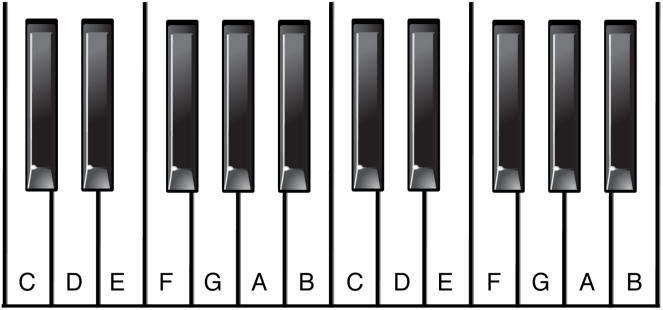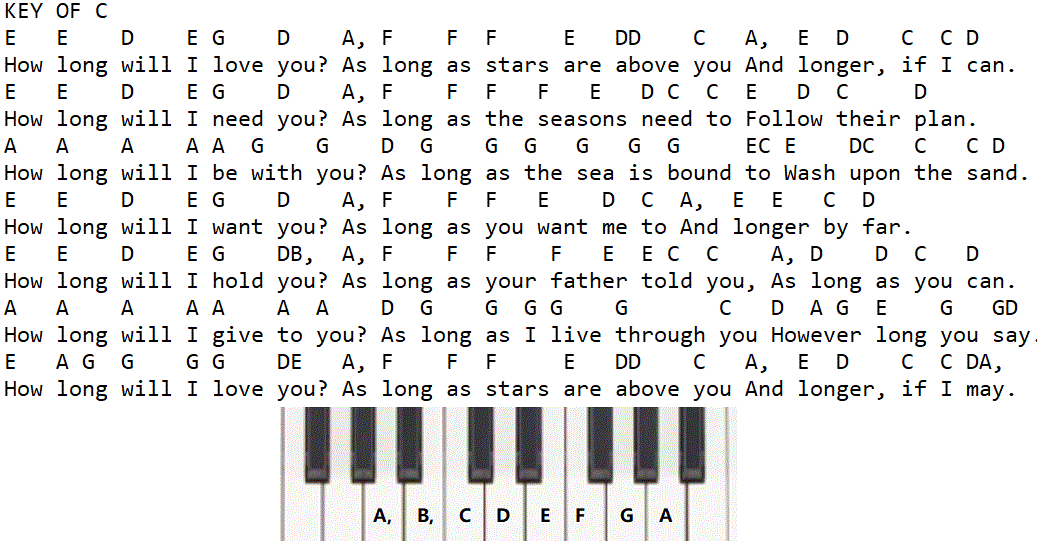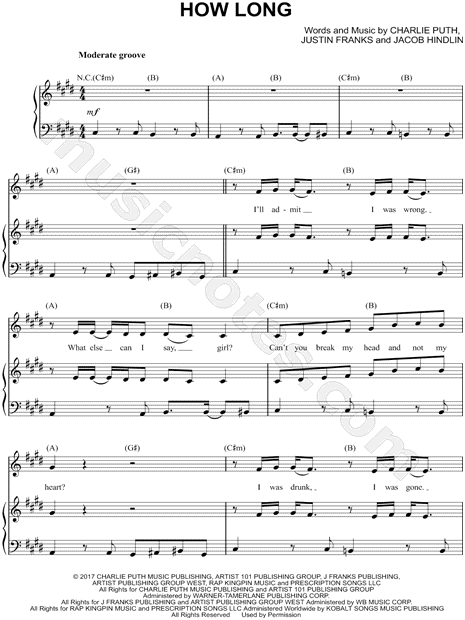The duration of piano notes varies depending on the tempo and the note value. For instance, a quarter note in a moderate tempo might last for one second.
Piano notes are the building blocks of all piano music, and their length can significantly affect a piece’s rhythm, emotion, and flow. Understanding how long to hold each note is crucial for musicians, from beginners learning their scales to advanced players interpreting complex compositions.
The timing of each note is guided by the tempo set by the composer and the specific note value, such as whole notes, half notes, quarter notes, and so on. A comprehensive grasp of note durations, paired with the piece’s tempo, contributes to the pianist’s ability to deliver a compelling performance. For anyone keen to master the piano, recognizing the variances in note lengths is an essential step toward fluency and expressiveness in their musical journey.

Credit: bluebirdmusiclessons.wordpress.com
The Essence Of Piano Note Durations
Understanding how long to hold piano keys down is like knowing how long to stir a pot of soup. It changes the taste! Note durations shape the melody and rhythm of a song, creating its unique flow and feeling.
Measuring Time In Music
To know when and how long to press piano keys, we use measures and beats. A measure is a small section of time in music. It’s like a musical “sentence.” Each measure has beats, which are steady pulses. Think of a clock ticking; each tick is like a beat.
- Musical staff shows measures with vertical lines.
- Beats depend on the time signature, a music piece’s “heartbeat.”
Fundamentals Of Piano Notes
Piano notes tell us two things: where to place our fingers and how long to hold the keys. Note symbols have unique looks and names like whole notes or quarter notes. They help us understand the duration.
| Note Type | Duration |
|---|---|
| Whole Note | Holds for 4 beats |
| Half Note | Holds for 2 beats |
| Quarter Note | Holds for 1 beat |
| Eighth Note | Holds for 1/2 a beat |
Look for the note’s shape to know its duration. For example, a whole note looks like a hollow circle, and it means you hold the key for four taps of your foot.

Credit: www.irish-folk-songs.com
Decoding Sheet Music: Note Length Indicators
Understanding the rhythm of a piano piece is like learning the language of music. Each symbol on a sheet of music plays a crucial role in telling musicians how long to hold each note. These instructions, known as note length indicators, guide players in expressing the intended feel and tempo of the piece.
Symbols And Their Meanings
Recognizing note symbols is the first step to mastering sheet music timing. Here is a glance at the core symbols:
- Whole Note (Semibreve) – Four beats.
- Half Note (Minim) – Two beats.
- Quarter Note (Crotchet) – One beat.
- Eighth Note (Quaver) – Half a beat.
- Sixteenth Note (Semiquaver) – A quarter of a beat.
Each symbol tells you how many beats to hold a note. As symbols get smaller, so does the note duration.
The Role Of Dots And Ties
Musical sheets use dots and ties to adjust note lengths. Here’s how:
| Symbol | Function | Effect |
|---|---|---|
| Dot after a note | Lengthens the note | Adds half of the note’s original value |
| Tie | Connects two notes | Combines their values into one sustained note |
A single dot adds half of the note’s value, while a tie combines notes of the same pitch into one prolonged sound. This can create unique rhythms and extend harmonies.
Touch And Technique: Achieving Desired Note Lengths
Mastering the piano involves much more than just hitting the keys. Touch and technique play pivotal roles in producing the precise note lengths desired. Note duration can deeply affect the emotion and resonance of a piece. This guide will explore the essential techniques pianists use to achieve perfect note lengths.
The Weight Of Touch
The weight of touch refers to how hard or soft a pianist presses a piano key. Varying the touch affects the sound’s intensity and duration. Here are some key insights:
- Forte (loud) notes require a firmer touch.
- Piano (soft) notes are achieved with a gentler press.
- A consistent pressure ensures even note lengths.
To practice, try playing scales with different dynamics to understand how the touch impacts note sustenance.
Sustain Pedal Usage
The sustain pedal, or damper pedal, is the secret to elongating note lengths beyond natural finger hold. Here’s how to use it effectively:
- Press the pedal down right after a key is struck for a seamless sound.
- Lift the pedal when changing chords to avoid sound muddiness.
- Employ partial pedaling for subtle note elongation.
Remember: The sustain pedal can create a beautiful legato effect or clear staccato notes when used correctly.
Rhythm And Tempo: Navigating Through Speed
Understanding how long to hold piano notes forms the essence of music’s rhythm and tempo. Rhythm sets the pattern of sound and silence in time. Tempo decides the speed of a song. Together, they shape the heartbeat of a piece. To weave melody with grace, pianists must master the subtle dance of rhythm and tempo.
Interpreting Tempo Markings
Tempo markings guide musicians on how fast or slow to play. Words like Allegro (fast) or Lento (slow) appear at a composition’s start. These terms provide an initial pulse. A metronome can translate these words into steady beats per minute (BPM). Common tempo markings and their BPM ranges include:
| Tempo | BPM |
|---|---|
| Largo | 40–60 BPM |
| Adagio | 66–76 BPM |
| Moderato | 108–120 BPM |
| Allegro | 120–168 BPM |
| Presto | 168–200 BPM |
Effect Of Tempo On Note Duration
Note duration changes with the tempo. A quarter note in a slow Adagio might feel long. The same note in a swift Presto flashes by. Visualizing these differences helps:
- Slow tempos mean longer hold times for notes.
- Fast tempos require quick, precise strikes on keys.
For example, in a Largo piece at 50 BPM:
- A quarter note lasts 1.2 seconds.
- A half note stretches to 2.4 seconds.
In an Allegro composition at 150 BPM:
- A quarter note takes only 0.4 seconds.
- A half note spans a swift 0.8 seconds.
Firm grasp of tempo ensures precise playing. It breathes life into the music. As each note finds its rhythm, the melody unfolds naturally.
Advanced Perspectives On Note Sustainment
Exploring the depths of piano note sustainment uncovers a world of advanced techniques. Mastery in these techniques transforms notes into rich, emotive musical experiences. Pianists employ varying methods to extend and control note sustainment, fueling expressive performances.
Articulation And Phrasing
Understanding articulation and phrasing is key to note sustainment. Proper articulation shapes each note’s onset and release, creating a desired musical effect. It involves aspects like:
- Legato (smooth and connected)
- Staccato (short and detached)
- Tenuto (held and sustained)
Phrasing connects notes in a musical sentence, guiding sustainment decisions. Influenced by melody and emotion, pianists breathe life into compositions through:
- Identifying phrase lengths
- Marking natural breaths
- Emphasizing key notes within a phrase
Dynamic Control And Expression
Dynamic control and expression affect note sustainment tremendously. Dynamics refer to volume levels in music and dictate note intensity. Mastery allows for:
| Dynamic Marking | Expression |
|---|---|
| piano (p) | Quiet and subdued |
| forte (f) | Loud and bold |
| crescendo | Gradually louder |
| decrescendo | Gradually softer |
Dynamic variation can imply longer or shorter note sustainment, conveying different emotions and tensions. Overall, dynamic nuances enable musicians to paint sonic landscapes, illustrating the narrative of the music.

Credit: www.musicnotes.com
Is the Length of Piano Notes Related to the Longevity of the Instrument?
The length of piano notes does not directly correlate with how long pianos last. The longevity of a piano is determined by factors such as maintenance, frequency of use, and the quality of materials. Regular tuning and proper care can significantly extend the lifespan of a piano.
Frequently Asked Questions For How Long Piano Notes
How Long Do You Hold Notes On A Piano?
The duration you hold piano notes depends on the piece’s tempo and the individual note’s indicated length – typically, a few seconds for standard notes.
How Long Does It Take To Learn Notes?
Learning to read music notes can vary in time, typically taking a few weeks to several months, depending on practice frequency and individual aptitude.
How Do You Hold A Piano Note?
To hold a piano note, press and sustain the key while keeping the corresponding pedal pressed down. Release both the key and pedal smoothly to end the note.
How Long Should Piano Notes Be Held?
Holding a piano note depends on the note’s value and the piece’s tempo. For instance, a quarter note in a moderate tempo might be held for one beat, while in a faster piece, it might be shorter.
Conclusion
Understanding the duration of piano notes is crucial for mastering the instrument. It shapes the melody and breathes life into compositions. We’ve uncovered key insights to help you become proficient. Keep practicing, and let the beauty of each note resonate with your audience.
Unlock the full potential of your pianistic expressions—note by note.
